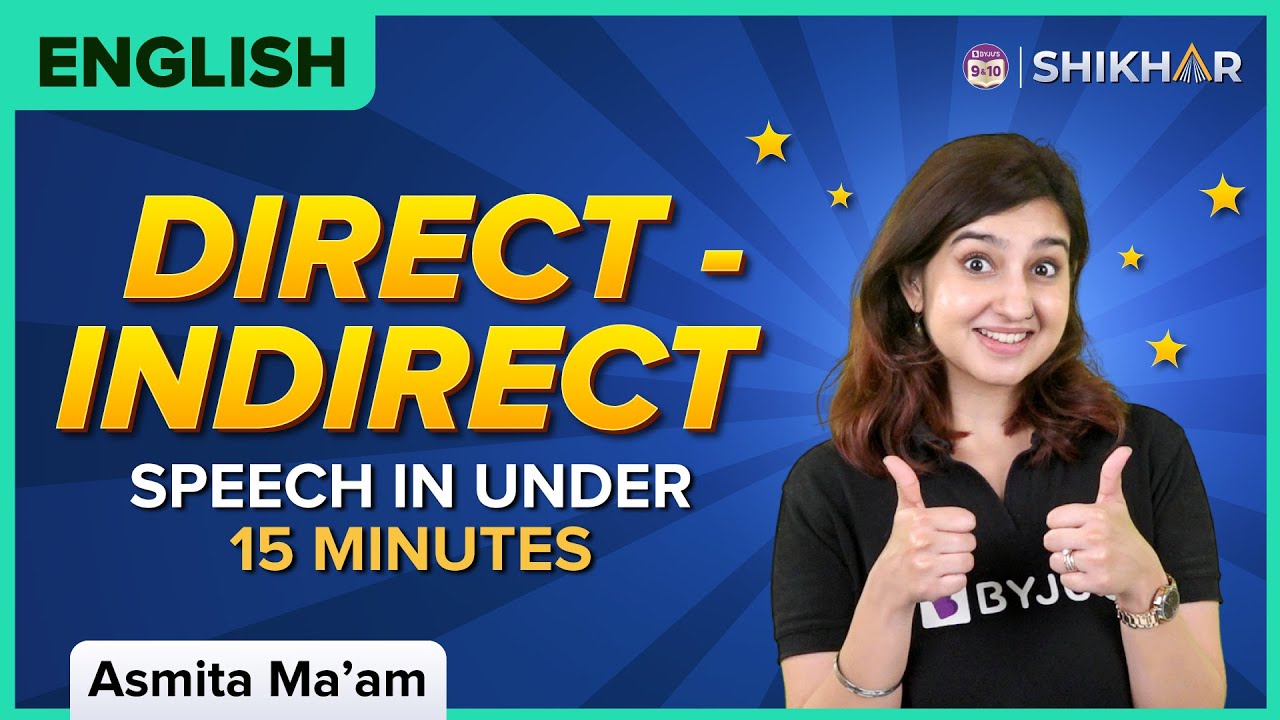Reported Speech | Penggunaan Direct Indirect Speech dan Contohnya
Summary
TLDRIn this video, the speaker introduces the concept of reported speech and its transformation from direct to indirect speech. The video explains key grammatical rules, such as changing verb tenses from present to past and adjusting pronouns and time references. Examples are provided to demonstrate the conversion of sentences, emphasizing rules like changing 'today' to 'that day' and 'tomorrow' to 'the next day.' The speaker also highlights the importance of punctuation, specifically commas and quotation marks, and offers practical examples. The video concludes with encouragement to ask questions and engage further.
Takeaways
- 😀 Reported speech refers to indirectly reporting what someone has said, rather than directly quoting their words.
- 😀 In reported speech, the structure changes from direct speech, e.g., 'Tom said, 'She will come here' to 'Tom said that she would come here.'
- 😀 In reported speech, we often change the tense of the verb. For example, 'She says I count on you' becomes 'She said that she counted on him.'
- 😀 The main clause in reported speech is usually followed by 'that', and we adjust pronouns and tenses accordingly.
- 😀 Reported speech involves two key components: the main clause (e.g., 'She said') and the reported speech itself (e.g., 'that she was sick').
- 😀 The verb tense changes in reported speech: present tense turns into past tense, and past perfect stays in the past perfect tense.
- 😀 When converting from direct to reported speech, certain time expressions change. For example, 'today' becomes 'that day' and 'yesterday' becomes 'the day before.'
- 😀 In reported speech, words like 'this' change to 'that,' and 'here' changes to 'there.'
- 😀 Example: 'He said, 'I am sick' becomes 'He said that he was sick.'
- 😀 It's important to practice reported speech with different examples, as the tense changes depend on the context of the speech.
Q & A
What is reported speech?
-Reported speech is when we report what someone else has said, either directly or indirectly, without quoting their exact words.
What is the difference between direct and indirect speech?
-Direct speech involves quoting someone’s exact words, while indirect speech involves paraphrasing what someone said, usually with some changes in tense and structure.
What is an example of direct speech?
-'Tom said, 'She will come here.'' is an example of direct speech.
What is an example of indirect speech?
-'Tom said that she would come here.' is an example of indirect speech.
What is the rule when changing from direct speech to indirect speech?
-When changing direct speech to indirect speech, the tense typically shifts back one step, such as from present to past tense, and other changes like pronouns are made according to the context.
What happens to the verb tense in reported speech?
-In reported speech, the verb tense often shifts one step back. For example, a present simple becomes past simple, and a present continuous becomes past continuous.
What is an example of changing a present simple sentence to indirect speech?
-'He says, 'I count on you.' becomes 'He says that he counts on me.' in indirect speech.
What is an example of changing a past simple sentence to indirect speech?
-'She said, 'I count on you.' becomes 'She said that she counted on him.' in indirect speech.
What is the rule for using 'that' in reported speech?
-In reported speech, 'that' is often used to introduce the reported statement, especially when it involves a subject or object. For example, 'She said that she counted on him.'
How do you handle time expressions like 'yesterday' and 'tomorrow' in indirect speech?
-Time expressions are adjusted when changing to indirect speech. For example, 'yesterday' becomes 'the day before,' and 'tomorrow' becomes 'the next day.'
Outlines

This section is available to paid users only. Please upgrade to access this part.
Upgrade NowMindmap

This section is available to paid users only. Please upgrade to access this part.
Upgrade NowKeywords

This section is available to paid users only. Please upgrade to access this part.
Upgrade NowHighlights

This section is available to paid users only. Please upgrade to access this part.
Upgrade NowTranscripts

This section is available to paid users only. Please upgrade to access this part.
Upgrade NowBrowse More Related Video

Learn English Grammar: INDIRECT SPEECH (REPORTED SPEECH)

Direct Indirect Speech / Kalimat Langsung dan Kalimat Tidak Langsung

Direct - Indirect (Reported) Speech in Under 15 Minutes | Class 9 and 10 | English | BYJU'S

BAHASA INGGRIS SMA - Reported Speech (Indirect & Direct Speech) | GIA Academy

BELAJAR DIRECT AND INDIRECT SPEECH (REPORTED SPEECH)

Learn English Grammar: DIRECT & INDIRECT SPEECH (REPORTED SPEECH)
5.0 / 5 (0 votes)